| The Callington
Branch Signal Boxes and Ground Frames |
|||||||||||||
|
|||||||||||||
This page deals specifically with the Signal Boxes and Ground Frames of the former Callington Branch railway line. Detailed information is provided about the specific signalling arrangements at each location on the line. See other RailWest pages for more specific details about the actual signals and the various methods of block working. Please click here for a general overview of Callington Branch signalling, or click here for an Index to all Callington Branch pages in RailWest.
The former East Cornwall Mineral Railway (ECMR) had a rudimentary form of signalling, but there is no indication that it had any form of signal-boxes. During its 1908 reconstruction and extension by the Plymouth, Devonport & South Western Junction Railway (PD&SWJR) the signalling was upgraded to a level in keeping with Light Railway status and signal-boxes were provided then at Bere Alston (branch line only), Calstock, Gunnislake, Luckett and Callington. However these boxes were in effect just ground-level lever-frames housed in simple wooden huts, usually with the block equipment (for control of the single-line sections) located in the station office. Facing points were fitted originally with 'economic' Facing Point Locks (FPL) worked from the same lever as the points, although in later alterations some FPLs were given their own levers. A couple of the smaller stations simply had a signal on the platform that was worked by station staff for 'request stop' purposes. There were also a number of small ground-frames (GF) at various intermediate sidings along the line.
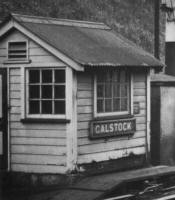 |
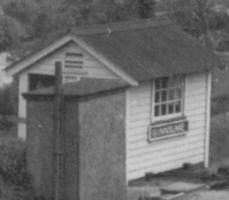 |
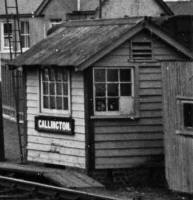 |
||
| The signal-boxes at Calstock, Gunnislake and Callington | ||||
BERE ALSTON. The Light Railway branch served the rear face of the island Up platform, with a connection into the London & South Western Railway (L&SWR) Up sidings and thence the Up Main. This connection was not signalled for passenger traffic and was controlled originally by a local 1-lever ground-frame, which was locked by a key held by the L&SWR signalman. The L&SWR signal-box stood on the Up platform at the Tavistock (east) end, but the Light Railway had its own branch signal-box squeezed in between the Plymouth (west) end of the branch platform and the adjacent road under-bridge. The 1908 Board of Trade (BoT) Inspection Report states that the branch signal-box had a 4-lever frame and it also contained the train staff apparatus for the single-line block section to Calstock. The lever-frame in the branch signal-box worked Up Home and Down Starting signals on the branch, the facing point and FPL at the Calstock end of the run-round loop, and a trap-point at the east end of the branch platform line which protected it from any movements from the sidings. At the eastern end of the branch platform face was the zero mileage point for the branch.
The branch signal-box was closed on 13-February-1927 and its work was transferred to the ex-L&SWR box, which was extended then at the Plymouth end and had its lever-frame increased from 17 to 30 levers. A Down Advanced Starting signal was provided on the branch and a number of ground shunt signals. After that alteration there appears to have been little change to the signalling at Bere Alston for many years, other than the renewal of various signals including those on the branch (click here for more details on the signals). The signal diagram for the period circa-1960 is probably little different from that for the preceding three decades.
After the closure of the ex-L&SWR main line to Tavistock on 6-May-1968 the trackwork on the branch side of the station was rationalised and the signalling was altered to facilitate through running of passenger trains between the Main and Branch lines. Both the Down Branch Starting and Down Branch Advanced Starting signals were abolished. The existing Up Branch Home was removed and a replacement signal erected close to the connection with the former Up Main, which was truncated to form a reversal spur. A new Spur Starting signal with a 2-route indicator was erected on the spur to control movements onto the Branch or the former Down Main, with FPLs being added to the points affected. Both these new signals were of the standard BR (Western Region) pattern. At the same a new Up Branch Distant (fixed at 'caution') was added, probably because of sighting difficulties with the re-located Up Branch Home. These changes took place on 26-January-1969, on which date the former Up Main was re-named Down Main and the Down Main became the Up Main. Click here for the revised 1969 signal diagram.
The ex-L&SWR signal-box was closed eventually on 7-September-1970 and the old main line to St Budeaux (on the outskirts of Plymouth) was reduced to single-track. The entire line from St Budeaux to Gunnislake became a single 'One Train Working' (OTW) section. The Gunnislake line was slewed across at the west (Plymouth) end of the station to connect into the former Down (now Up) Main line at a new junction, controlled by an adjacent new 2-lever ground-frame unlocked by a key on the OTW staff. Thereafter all trains used the former Down (now Up) Main platform only and the island Up Main/Branch platform was taken out of use. All the signals were removed, except for the fixed Up Distant signal approaching from Calstock and the fixed Down Distant approaching from Plymouth. Subsequently both those Distant signals were replaced by modern reflectorised distant boards in July 1989. More details about the history of Bere Alston station can be found on a separate page.
CALSTOCK. The signal-box stood at the Callington end of the station at 1 mile 68 chains and originally it contained a 4-lever ground-level lever-frame, which worked the points at each end of the loop siding and Home signals in each direction. The Down Home had an additional repeater signal near the Bere Alston end of the viaduct, which was worked from the same wire. The block equipment for the single-line sections to Bere Alston and Gunnislake was kept in the station office.
After complaints from the railway staff about the stiffness of the levers, the lever-frame was replaced in 1937 (sometime between 30th April and 16th July) by a frame of 10 levers, which was fitted at the back of the signal-box. (It is unclear if the original lever-frame was located at the front or back of the signal-box.) As part of this alteration the 'repeater' Down Home signal become an independent Down Outer Home, now worked by a separate lever from that for the existing Down (Inner) Home.
The signal-box was closed on 5-May-1968, at which time the station ceased to be a block-post and all the signals and sidings were abolished. During the early part of 1994 the station temporarily became a terminus, as passengers services onwards to Gunnislake were suspended during the construction of the new Gunnislake station; a stop-block was fitted at 1m 58c and a temporary reflectorised 'fixed' distant board was erected on the approach to Calstock at 1m 37c 16yd.
GUNNISLAKE. This was the main intermediate station on the line and the only passing-loop, which unusually had just a single island platform between the Up and Down loops. Home and Starting signals were provided in each direction and there were trailing connections to sidings off both loops. At the Callington end of the station there was an additional connection to the Down sidings off the single line, facing to Up trains. The ground-level signal-box was situated outside the Up loop at the Callington end at 4 miles 60 chains and it contained a ground-level lever-frame of 10 levers, all of which were in use at the time of the 1908 BoT Inspection. The block equipment for the single-line sections to Calstock and Callington was kept in the station office.
The Up Starting signal was originally in rear of the trailing connection to the Up Siding, but during the mid-1930s an increase in the length of ballast trains from Hingston Down meant that there was insufficient length in the Up Loop when passing trains, so on 8-October-1936 the signal was renewed 53 yards further from the box. It was suggested that a Mechanical Depression Bar should be provided at the fouling point with the siding (a similar arrangement already existing on the Down Loop), but this idea was rejected in favour of the following addition to the Special Instructions:
"When a passenger train is standing in the up loop line no movement must be made to or from the up siding except any necessary shunting operation carried out by the engine of such passenger train."
In 1938 attention turned to the matter of the Down Home signal, which at that time was 28' high and located 206 yards from the Down Loop facing points on the 'wrong' right-hand side of the line. It was considered that this signal should be moved to the correct left-hand side of the line and also brought much closer to the facing points, but in the new position it could not be seen for a distance of 440 yards by an approaching train and so a distant signal would be needed to comply with Ministry of Transport Requirements. On 20-July-1938 the Down Home was renewed 145 yards nearer the signal-box and a new Down Distant was provided 800 yards in rear of the relocated Home, both signals being 13' 6" high.
When the portion of the branch from Gunnislake to Callington was closed completely on 7-November-1966 the single-line was truncated approximately at the position of the Up Home signal. By this time the only siding which remained in use was the one adjacent to the Down Loop (accessed by points 5). The signal-box at Gunnislake remained open and there appears to have been no change to the block working nor the signalling at Gunnislake, so that terminating Down trains had to shunt across to the Up platform in order to re-start as Up trains.
This arrangement appears to have continued until the signal-box was closed on 5-May-1968 (Calstock signal-box was closed on the same date also). Thereafter the station became the terminus of a single One-Engine-in-Steam section from Bere Alston, with all trains using the former Up platform face; the Down loop and remaining Down siding were taken out of use and later removed. All the signals were removed except for the Down Distant, which subsequently was replaced by a modern reflectorised distant board in July 1989. This board was relocated to 4m 12ch 19yds when the new Gunnislake station was opened in 1994.
CHILSWORTHY. Old photographs of this station show a signal-post on the platform with two stop arms (for opposing directions). These arms were slotted into the post and had no spectacle plates. It is likely that these signals were used solely to make 'request stops' for passenger trains, in a similar manner to the original arrangements described at Latchley. It is not known when these signals were removed.
LATCHLEY. The 1908 BoT Inspection Report records that "...there is a home signal in each direction worked from the platform whenever it is required to stop a train...". This was probably a similar arrangement to that which existed at Chilsworthy. It is not known when these signals were removed. There was a siding on the Up side accessed by a connection facing to Down trains and controlled by a ground-frame (GF), which was unlocked by a key on the train staff (later by the electric train.tablet) for the Gunnislake - Callington section. The siding and GF were taken out of use at an unknown date after 1950.
SEVEN STONES HALT. There is no known photographic record of any signals at Seven Stones. The PD&SWJR timetable for 1912 (click here to see a version re-drawn for clarity) did state that trains stopped there 'by signal' and the same annotation was given for Chilsworthy and Latchley, so it would seem a reasonable assumption therefore that the Halt was provided with a similar arrangement of signals to that which existed at Chilsworthy. However it should be noted that the timetable also states that "...trains only stop for Excursion parties, by arrangements..." so one might question whether in fact any permanent signals would have been necessary. It must be assumed that any signals would have been abolished when the Halt was closed during World War I.
LUCKETT (Stoke Climsland). The 1908 BoT Inspection Report records a 225' platform (on the Down side) "..with Home signals at each end...". There was a loop siding on the Up side and a further siding on the Down side at the Gunnislake end of the platform. There was a ground-level signal-box, which stood on the Up side at the Callington end of the loop. This signal-box contained a 4-lever ground-level lever-frame which worked the two Home signals, the points at the Callington end of the loop siding and the Up siding points. The points at the Gunnislake end of the loop were worked by an adjacent 1-lever GF, which was unlocked by a key kept in the signal-box lever-frame. The Down siding was taken out of use on 31-March-1925. The loop siding and both GFs were taken out of use on 23-September-1962.
There is some uncertainty about the status and history of Luckett signal-box. Although the BoT Inspection Report specifically mentions a "signal-box", it is known from the information about staff/tablet sections contained in the same Report that this was not a block post originally. This was definitely the case by 1916, as a further BoT Inspection Report dated 27-May-1916 records that an intermediate Electric Train Tablet instrument had been installed at Luckett. However Southern Railway (SR) Signal Instruction 16 of 1923, issued on 12-July-1923, stated "Luckett station....has been abolished as a tablet section, the section now being between Callington and Gunnislake. The up and down home signals...have been removed.", although no actual date was given for those alterations.. Another source states that the signal-box was reduced to GF status on 8-July-1923. The reference to 'tablet section' seems contradictory, unless perhaps Luckett had been upgraded to a block post since 1916? Perhaps it was the case that the Signal Instruction refers simply to the removal of the intermediate tablet instrument and that the downgrading from signal-box status merely refers to the removal of the signals?
CALLINGTON. The ground-level signal-box was located originally at the east (Gunnislake) end of the station platform at 9 miles 55 chains and it contained a 5-lever ground-lever lever-frame. At the time of the 1908 BoT Inspection Report this lever-frame worked Down Home and Up Starting signals, the points at the west (station) end of the run-round loop, the points for the siding adjacent to the platform line and the points leading into the west end of the engine-shed. The points at the east (Gunnislake) end of the run-round loop were worked by an adjacent 1-lever GF, which was unlocked by a key from the lever-frame in the signal-box. The block equipment for the single-line section to Gunnislake was kept in the station office.
In 1916 a new connection was installed on the up side of the line east of the engine-shed, which was facing to Down trains and gave access to cattle sidings. The relevant BoT Inspection Report states that "..these points, together with all the other siding connections in the station, are worked from ground frames of one lever each, which are locked by the electric tablet for the section...". It is not clear how to interpret the reference to "all...connections", as the 5-lever frame in the signal-box was still in use at a later date, but it suggests that at least the new connection was provided with its own GF rather than being controlled by an extension of the original east GF. This view is reinforced by the fact that, when subsequently a new 4-lever GF was installed at the east end of the station on 14/15-September-1926, the relevant SR Signalling Instruction No 30 of 1926 refers to the removal of the "existing three single-lever ground-frames". It would appear that subsequently this 4-lever GF was in turn replaced by a 3-lever GF, allegedly in 1946. Although the GF itself was uncovered, immediately behind it stood a rudimentary 3-sided shelter apparently made from corrugated-iron sheeting and presumably intended to provide some protection for the operator (click here for image). In BR days the east GF was listed as being 208 yards from the signal-box.
Further extensive changes to the layout took place in 1928, with modifications to some of the sidings and alterations of the various connections to the main line. In particular the existing tracks into the west end of the engine shed were removed and a new access provided from the east end. The siding next to the platform line was connected to the run-round loop instead of the main line, and therefore ceased to be controlled from the signal-box. The platform was lengthened by 94' at the eastern end and as a result the signal-box was moved about 20 yards nearer Gunnislake (5th February). All these changes were detailed in an Inspection Report dated 13-May-1929.
 |
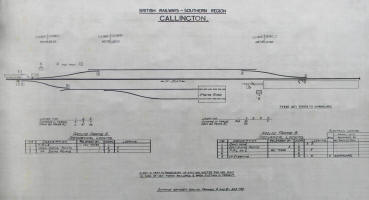 |
|
| Callington Signal Diagram circa-1960 Click diagram for larger image |
Callington Signal Diagram & Locking Tables post-1962 Click diagram for larger image |
It appears that, by the time of the 1916 BoT Inspection Report, the east GF was unlocked by the tablet for the single-line section instead of a key from the signal-box as originally installed. It is curious that, in contrast to the arrangements at the other signal-boxes on the line, the points worked from Callington box itself were locked also by the tablet. In this connection the following Special Instruction appeared in the 1934 Working Timetable Appendix:-
"Failure of tablet apparatus. A key, to enable the points leading to and from the sidings at Callington (which are normally released by the tablet), to be operated in case of emergency, is kept in the Station Master's office. This key must be used only in cases where, owing to a failure of the tablet apparatus or other emergency, the tablet cannot be obtained from the instrument in the ordinary way and working by Pilotman is in operation over the section affected. In these circumstances the key must be used only in the presence of the Pilotman, and after the necessary shunting movement over the connection affected has been carried out and the points replaced to their normal position, the key must be returned to the Station Master's office."
The use of such a release key seems unusual and it is not known when it was introduced, although it is mentioned in the 1916 BoT Inspection Report and may be linked to the conversion of the Gunnislake - Callington section to ETT working at that time. After the block working for the section to Gunnislake was changed again in 1962 to EKT working a token-like replacement emergency key was provided (click here for image).
 The photograph
on the right (click for larger image) shows the inside of the
signal-box in 1965. The lever-frame is of the Stevens-pattern 'knee' type,
but manufactured by the Railway Signalling Company of Liverpool. Given that
it is a 5-lever frame with lever 4 spare, this suggests that it pre-dates
the 1928 alterations and therefore is probably the original frame.
Attached to lever 3 can be seen the key-token (or equivalent emergency key)
release lock for the FPL (and hence the points). There is evidence on that
lever that at one time it was fitted with a lever description plate, which
may indicate that prior to 1962 the earlier tablet lock had been
fitted in a different manner. The equipment attached behind and below the
right-hand end of the frame is probably part of the 'token out' release
mechanism for lever 5. The round indicator mounted on the window-sill was
probably an arm indicator for the Down Home signal (No 1), which would have
been out-of-sight of the signalman.
The photograph
on the right (click for larger image) shows the inside of the
signal-box in 1965. The lever-frame is of the Stevens-pattern 'knee' type,
but manufactured by the Railway Signalling Company of Liverpool. Given that
it is a 5-lever frame with lever 4 spare, this suggests that it pre-dates
the 1928 alterations and therefore is probably the original frame.
Attached to lever 3 can be seen the key-token (or equivalent emergency key)
release lock for the FPL (and hence the points). There is evidence on that
lever that at one time it was fitted with a lever description plate, which
may indicate that prior to 1962 the earlier tablet lock had been
fitted in a different manner. The equipment attached behind and below the
right-hand end of the frame is probably part of the 'token out' release
mechanism for lever 5. The round indicator mounted on the window-sill was
probably an arm indicator for the Down Home signal (No 1), which would have
been out-of-sight of the signalman.
It is interesting to note that by British Railways days both the lever-frames at Callington were labelled as 'ground frames', the frame at the east end being identified as GF 'A' and the box by the platform as GF 'B'. The signal-box and east ground-frame were closed on 5-November-1966 when the line beyond Gunnislake was closed completely.
Ground Frames and Intermediate Sidings
Ground-frames (GF) existed at Bere Alston, Luckett and Callington stations, in addition to the main signal-boxes at those locations, and these have been described above in the details about their respective stations. However there were also a number of GFs at various intermediate sidings along the line, but the precise type of lever-frame that was used originally is unknown. At the time of the 1908 BoT Inspection intermediate sidings existed at the following locations:- Refuge, Perry Spear's, Cockings, Green Hill, Clitters, Hingston Down, Latchley, and Kit Hill. Additional sidings existed subsequently at Hill Westlake and Whiterock. Each of these sidings had a single GF controlling the connection to the main line, although after some alterations circa-1919 there were two separate GFs at Hingston Down. Click here for more details about the various sidings.
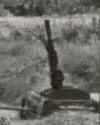 Refuge and Perry Spear's sidings were located in the section between Calstock and
Gunnislake and their GFs were unlocked by the tablets for that section. All the other
sidings were situated between Gunnislake and Callington and therefore originally were
unlocked by the train staff for that section until the change to tablet working. All the
original GFs were simple 1-lever frames, because the siding points were fitted with
'economic' FPLs. However during the 1920s many of those economic FPLs were replaced by the
ordinary type worked by a separate lever, so the associated GFs were renewed as 2-lever frames. The
photograph on the right (click for larger image) shows the replacement
2-lever GF at Kit Hill in 1949, with the tablet release lock visible near the
bottom of the first lever. The following GF replacements are known
(although others may have taken place also):-
Refuge and Perry Spear's sidings were located in the section between Calstock and
Gunnislake and their GFs were unlocked by the tablets for that section. All the other
sidings were situated between Gunnislake and Callington and therefore originally were
unlocked by the train staff for that section until the change to tablet working. All the
original GFs were simple 1-lever frames, because the siding points were fitted with
'economic' FPLs. However during the 1920s many of those economic FPLs were replaced by the
ordinary type worked by a separate lever, so the associated GFs were renewed as 2-lever frames. The
photograph on the right (click for larger image) shows the replacement
2-lever GF at Kit Hill in 1949, with the tablet release lock visible near the
bottom of the first lever. The following GF replacements are known
(although others may have taken place also):-
None of the sidings or their ground-frames remained after 1966.
© CJL Osment 2004-22
Re-drawn 1912 PD&SWJR timetable courtesy Bruce Hunt, all other images WCRA collection